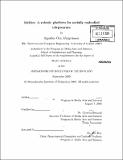MeBot : A robotic platform for socially embodied telepresence
Author(s)
Ađalgeirsson, Sigurđur Örn
DownloadFull printable version (17.21Mb)
Alternative title
Robotic platform for socially embodied telepresence
Other Contributors
Massachusetts Institute of Technology. Dept. of Architecture. Program in Media Arts and Sciences.
Advisor
Cynthia Breazeal.
Terms of use
Metadata
Show full item recordAbstract
Telepresence refers to a set of technologies that allow users to feel present at a distant location, telerobotics is a subfield of telepresence. Much work has been done in telerobotics through the years to provide safer working environments for people or to reach locations that would otherwise be inaccessible. More recently telerobots have been developed for communication purposes but as of yet they have not accommodated for other channels of communication than audio or video. The design and evaluation of a telepresence robot that allows for social expression is the content of this thesis. Our claim is that a telerobot that communicates more than simply audio or video but also expressive gestures, body language or pose and proxemics will allow for a more engaging and enjoyable interaction. An iterative design process of the MeBot platform is described in detail as well as the design of supporting systems and various control interfaces. A human subject study was conducted where the effects of expressivity were measured. Our results show that a socially expressive robot was found to be more engaging and likable than a static one. It was also found that expressiveness contributes to more psychological involvement and better cooperation.
Description
Thesis (S.M.)--Massachusetts Institute of Technology, School of Architecture and Planning, Program in Media Arts and Sciences, 2009. Cataloged from PDF version of thesis. Includes bibliographical references (p. 151-156).
Date issued
2009Department
Program in Media Arts and Sciences (Massachusetts Institute of Technology)Publisher
Massachusetts Institute of Technology
Keywords
Architecture. Program in Media Arts and Sciences.